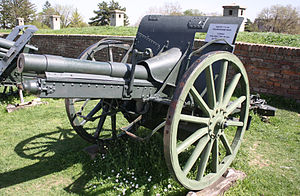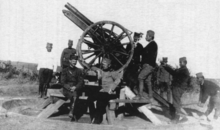| This article includes a list of general references, but it lacks sufficient corresponding inline citations. Please help to improve this article by introducing more precise citations. (February 2012) (Learn how and when to remove this message) |
| 03 L/30 | |
|---|---|
 A Turkish 7.5cm Krupp field gun M1903 A Turkish 7.5cm Krupp field gun M1903 | |
| Type | Field gun |
| Place of origin | |
| Service history | |
| In service | 1904–1945 |
| Used by | See users |
| Wars | Balkan Wars Xinhai Revolution World War I World War II |
| Production history | |
| Designer | Krupp |
| Manufacturer | Krupp |
| Specifications | |
| Mass | 1,079 kg (2,379 lb) |
| Barrel length | 2.25 m (7 ft 5 in) L/30 |
| Crew | 7 |
| Shell | Fixed QF 75 x 280 R 6.52 kilograms (14.4 lb) |
| Caliber | 75 mm (2.95 in) |
| Breech | Horizontal sliding-block |
| Recoil | Hydro-spring |
| Carriage | Pole trail |
| Elevation | -9° to +15° |
| Traverse | 7° |
| Rate of fire | 8 rpm |
| Muzzle velocity | 546 m/s (1,790 ft/s) |
| Maximum firing range | 6,000 m (6,600 yd) |
The Krupp 7.5 cm Model 1903 was a field gun used by a number of European armies in both World War I and World War II.
History
The Model 1903 was manufactured for export by Krupp. It was a "stock gun", meaning that it could be supplied to customers on short notice with minor alterations to suit the customers needs.
The German army of World War I did not use the Krupp 7.5 cm Model 1903. It had acquired the rather conventional 7.7 cm FK 96 as its standard gun in 1896. When the French army acquired the Canon de 75 modèle 1897 with hydraulic recoil mechanism in 1897, the FK 96 became obsolete. The model was then changed to become the 7.7 cm FK 96 n.A., which retained the barrel, but put it on a recoil mechanism and new carriage.
Operators and service
Romania
Romania acquired 636 guns and gave them the designation Tunul de câmp Krupp, cal. 75 mm, md. 1904. They used a more sophisticated sighting device (than the one offered by the Germans) made locally, known as the Ghenea-Korodi sight. By number of guns, this was largest import of a single type of cannon ever made by Romania. It was the mainstay of the Romanian field artillery in World War I, equipping all artillery regiments of the Romanian infantry divisions. The number of these guns in Romanian service had decreased to 312 by 1926. The Romanians used them until 1942, although by this time they had become obsolete.
Belgium
The Belgians bought a license to produce the M1903 at the Fonderie Royal des Cannons and were given the designation Canon de 7c5 M 1905 TR et TRA. They were used by Belgium during the First World War and Second World War. The Germans gave captured Belgian guns the designation 7.5 cm Feldkanone 235(b). It was also used by Belgian's King Leopold II's forces in Congo.
Netherlands
The Dutch bought some 204 of the slightly earlier Kanone M.02/03 and purchased a production-license as well. 120 appear to have been manufactured in the Netherlands, where it was known as the 7-veld. During the 1920s, the Dutch Siderius company a Krupp subsidiary rebuilt their guns to increase their elevation. At least 16 were modified for motorized traction, presumably with steel wheels and pneumatic tires, for service with the Light Division. Gander and Chamberlain claim there were three almost identical versions, the M 02/04, OM 04 and NM 10, but this has not been confirmed. The Germans designated these guns as the 7.5 cm Feldkanone 243(h) after the Battle of the Netherlands.
Denmark
The Model 1903 was also bought by Denmark and used in World War II. In Danish service it was known as the 03 L/30 and does not appear to have been modified in any significant way before World War II. Danish guns were known in German service as the 7.5 cm Feldkanone 240(d).
Serbia

During the First Balkan War 126 field and 6 mountain Ottoman Krupp 7.5 cm Model 1903 guns were captured by the Royal Serbian Army. In the beginning of the WWI the field guns were mounted on improvised wooden AA platforms designed by French captain Mortureux, and one of those achieved the first shootdown of an aircraft by ground fire in history.
Japan
The Model 1903 also formed the basis for the Type 38 75 mm Field Gun used by Japan.
Israel
During the 1947–1949 Palestine war, Israel purchase 50 surplus Krupp 7.5 cm Model 1903 guns from Romania.
Six salvaged Sherman tanks were temporarily equipped with Krupp field guns until 105mm howitzers were obtained to replace them.
Other users
 Republic of China
Republic of China Nazi Germany
Nazi Germany Ottoman Empire
Ottoman Empire Thailand
Thailand Qing dynasty
Qing dynasty Korean Empire
Korean Empire Switzerland
Switzerland Brazil
Brazil
References
- "Krupp 75mm 1904_Romania". www.bulgarianartillery.it. Retrieved 2021-02-21.
- Adrian Stroea; Gheorghe Băjenaru (2010). Artileria română în date şi imagini (PDF) (in Romanian). Editura Centrului Tehnic-Editorial al Armatei. pp. 45–46. ISBN 978-606-524-080-3. Archived from the original (PDF) on 2012-03-20. Retrieved 2013-09-05.
- "The fall of the Congo Arabs". 1897.
- Almeida, Fábio (2019). Fortaleza imaginária: A construção do patrimônio cultural pelos diferentes discursos sobre o Forte de Coimbra e seu contexto histórico-paisagístico (PDF) (MA thesis) (in Portuguese). National Institute of Historic and Artistic Heritage.
Bibliography
- Chamberlain, Peter & Gander, Terry. Light and Medium Field Artillery. New York: Arco, 1975
- Hogg, Ian Twentieth-Century Artillery. New York: Barnes & Nobles, 2000 ISBN 0-7607-1994-2
- Gander, Terry and Chamberlain, Peter. Weapons of the Third Reich: An Encyclopedic Survey of All Small Arms, Artillery and Special Weapons of the German Land Forces 1939-1945. New York: Doubleday, 1979 ISBN 0-385-15090-3
External links
- Dutch guns on War over Holland
- Version for Romania (1904): Krupp 75mm field gun M. 1904; cavalry version; Canon Krupp 75mm Mle 1904 à Bucarest (museum); Photos of exemplar captured first by the Turks and then by the Australians
- Turkish versions: data for M1903 M1910 M1911; database/photographs of exemplars captured in Palestine and now found in Australia Archived 2017-05-01 at the Wayback Machine